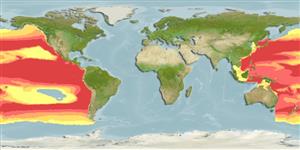>
Anguilliformes (Eels and morays) >
Serrivomeridae (Sawtooth eels)
Etymology: Serrivomer: Latin, serran, serranus, saw + Latin, vomer = ploughshare; in fishes = bone forming the front part of the roof of the mouth (1823) (Ref. 45335); sector: sector apparently alludes to the manner in which the platelike vomer divides the roof of the mouth into equal parts (Ref. 4525).
More on author: Garman.
Environment: milieu / climate zone / depth range / distribution range
Ecología
marino batipelágico; rango de profundidad 0 - 3243 m (Ref. 58018), usually 305 - ? m (Ref. 35595). Deep-water
Western Pacific: Japan (Ref. 559). Eastern Pacific: California, USA (Ref. 7182) to Chile (Ref. 9068, 35590).
Tamaño / Peso / Age
Maturity: Lm ? range ? - ? cm
Max length : 76.0 cm TL macho / no sexado; (Ref. 4525)
Meso- and bathypelagic (Ref. 58302). Feeds primarily on crustaceans, and to a lesser extent upon small cephalopods and fishes (Ref. 4525).
Life cycle and mating behavior
Madurez | Reproducción | Puesta | Huevos | Fecundidad | Larva
Eschmeyer, W.N., E.S. Herald and H. Hammann, 1983. A field guide to Pacific coast fishes of North America. Boston (MA, USA): Houghton Mifflin Company. xii+336 p. (Ref. 2850)
IUCN Red List Status (Ref. 130435)
Threat to humans
Harmless
Human uses
Más información
Nombres comunesSinónimosMetabolismoDespredadoresEcotoxicologíaReproducciónMadurezPuestaAgregación para la puestaFecundidadHuevosEgg development
ReferenciasAcuiculturaPerfil de acuiculturaRazasGenéticaElectrophoresesheritabilidadEnfermedadesProcesamientoNutrientsMass conversion
Herramientas
Special reports
Download XML
Fuentes de Internet
Estimates based on models
Preferred temperature (Ref.
123201): 3.2 - 12, mean 5.8 °C (based on 1343 cells).
Phylogenetic diversity index (Ref.
82804): PD
50 = 0.5059 [Uniqueness, from 0.5 = low to 2.0 = high].
Bayesian length-weight: a=0.00102 (0.00046 - 0.00225), b=3.06 (2.88 - 3.24), in cm total length, based on all LWR estimates for this body shape (Ref.
93245).
Nivel trófico (Ref.
69278): 3.8 ±0.54 se; based on food items.
Generation time: 3.7 ( na - na) years. Estimated as median ln(3)/K based on 1
growth studies.
Resiliencia (Ref.
120179): Bajo, población duplicada en un tiempo mínimo de 4.5-14 años (Assuming tmax>10).
Fishing Vulnerability (Ref.
59153): Moderate vulnerability (44 of 100).
